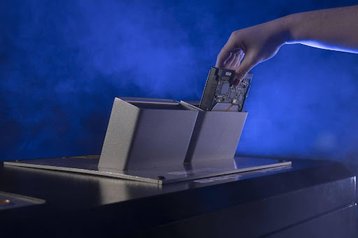In the vast and complex world of data centers, the maximization of space isn’t just a matter of practicality; it is a crucial aspect that has the power to directly affect a facility’s efficiency, sustainability, flow of operations, and, frankly, financial standing.
Today, information isn’t just power, but rather the lifeblood for countless industries and systems, making data centers stand as literal bodyguards of this priceless resource. With the ever-expanding volume of data being generated, stored, and processed, the effective use of space within these centers has become more critical than ever.
In layman’s terms, every square foot of a data center holds tremendous value and significance.
We’re not here to focus on how you can maximize the physical space of your data center; we’re not experts in which types of server racks will allow more floor space or which HVAC unit will optimize airflow.
What we focus on is our expertise in high-security data destruction, an aspect of data center infrastructure that holds an equal amount of value and significance. We’re also going to focus on the right questions you should be asking when selecting destruction solutions. After all, size and space requirements mixed with compliance regulations are aspects of a physical space that need to be addressed when choosing the right solution.
So, we are posing the question, “When every square foot counts, does an in-house destruction machine make sense?”
The important questions
Let’s start with the basic questions you need to answer before purchasing any sort of in-house data destruction devices.
1) What are your specific destruction needs (volume, media type, compliance regulations, etc.) and at what frequency will you be performing destruction?
The first step in determining if an in-house destruction solution is the right move for your facility is assessing your volume, the types of data you store, and whether you will be decommissioning on a regular basis. Are you only going to be destroying hard drives? Maybe just solid state media? What about both? Will destruction take place every day, every month, or once a quarter?
It’s important to consider factors such as the sensitivity of the data and any industry-specific regulations that dictate the level of security required. Additionally, a high volume of data decommissioning might justify the investment in in-house equipment, while lower-volume needs might require a different kind of solution.
2) How much physical space can you allocate for in-house equipment?
By evaluating the available square footage in a data center, management can ensure that the space allocated for the data destruction equipment is not only sufficient for the machinery but will also allow for efficient workflow and compliance with safety regulations. The dimensions for all our solutions can be found on our website within their respective product pages.
3) What is your budget for destruction solutions?
Determining budget constraints for acquiring and maintaining in-house data destruction will allow you to consider not only the upfront costs but also ongoing expenses such as maintenance, training, and potential upgrades. It’s important to note that, in addition to evaluating your budget for in-house equipment, the comparison between an in-house solution and cost of a data breach should also be taken into consideration.
All the answers to these questions will help determine the type of solution (shredder, crusher, etc.), compliance regulation (HIPAA, NSA, etc.), the physical size, and if there should be any custom specifications.
Data breaches: A recipe for financial catastrophes
One of the primary drives behind ensuring optimal space is the financial element. Building and maintaining data center infrastructures come with significant expenses; from real estate and construction to cooling and hardware installations. It’s crucial to maximize both the physical space and budget to get the most bang for your buck.
Even beyond physical constraints and considerations, the financial implications can loom overhead, especially in the context of data security.
Data breaches represent not just a threat to digital security but also a financial consequence that can reverberate for years. The fallout from a breach extends far beyond immediate remediation costs, encompassing regulatory fines, legal fees, public relations efforts to salvage a damaged reputation, and the intangible loss of customer trust.
For example, from January to June 2019, there were more than 3,800 publicly disclosed data breaches, resulting in 4.1 billion compromised records. The IBM and Ponemon Institute report found that the cost of an average data breach in 2023 is $4.45 million, a 15 percent increase over the past three years.
While making the best use out of your budget to bring in the necessary equipment and storage capability to truly use up every square foot of space, part of that budget consideration should also include secure in-house solutions.
Some will ask, “as long as I outsource my destruction obligations, I can maximize my physical space with other equipment?”
Not exactly.
The hidden costs of outsourced data destruction
Outsourcing data destruction has been a common practice, with the aim of offloading the burden of secure information disposal. However, introducing third party data sanitization vendors into your decommissioning procedures can gravely increase the chain of custody, resulting in a far higher risk of data breaches.
Third-party service contracts, transportation costs, and delays in data destruction contribute to an ongoing financial outflow. More so, the lack of immediate control raises concerns about the security of sensitive information during transit.
In July 2020, Morgan Stanley came under fire for an alleged data breach of their clients’ financial information after an IT asset disposition (ITAD) vendor misplaced pieces of computer equipment that had been storing customers’ sensitive personally identifiable information (PII).
While ITADs certainly have their role within the data decommissioning world, as facilities accumulate more data, and as the financial stakes continue to rise, the need to control the complete chain of custody (including in-house decommissioning) becomes more and more crucial.
In-house data destruction: A strategic financial investment
Now that your questions have been answered and your research has been conducted, it’s time to (officially) enter the realm of in-house data destruction solutions – an investment that not only addresses security concerns but aligns with the imperative to make every square foot count.
It’s crucial we reiterate that while the upfront costs associated with implementing an in-house destruction machine may appear significant, they must be viewed through the lens of long-term cost efficiency and risk mitigation.
In the battle against data breaches, time is truly of the essence. In-house data destruction solutions provide immediate control over the process, reducing the risk of security breaches during transportation and ensuring a swift response to data disposal needs. This agility becomes an invaluable asset in an era where the threat landscape is continually evolving.
In-house data destruction emerges not only as a means of maximizing space but as a financial imperative, offering a proactive stance against the potentially catastrophic financial repercussions of data breaches.
Whether your journey leads you to a Model 0101 Automatic Hard Drive Crusher or a DC-S1-3 HDD/SSD Combo Shredder, comparing the costs of these solutions (and their average lifespan) to a potential data breach resulting in millions of dollars, makes your answer that much simpler: by purchasing in-house end-of-life data destruction equipment, your facility is making not only the safest, but the most secure, cost-effective decision.



